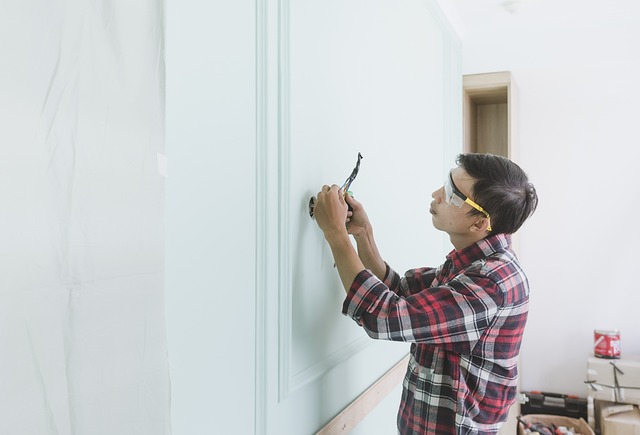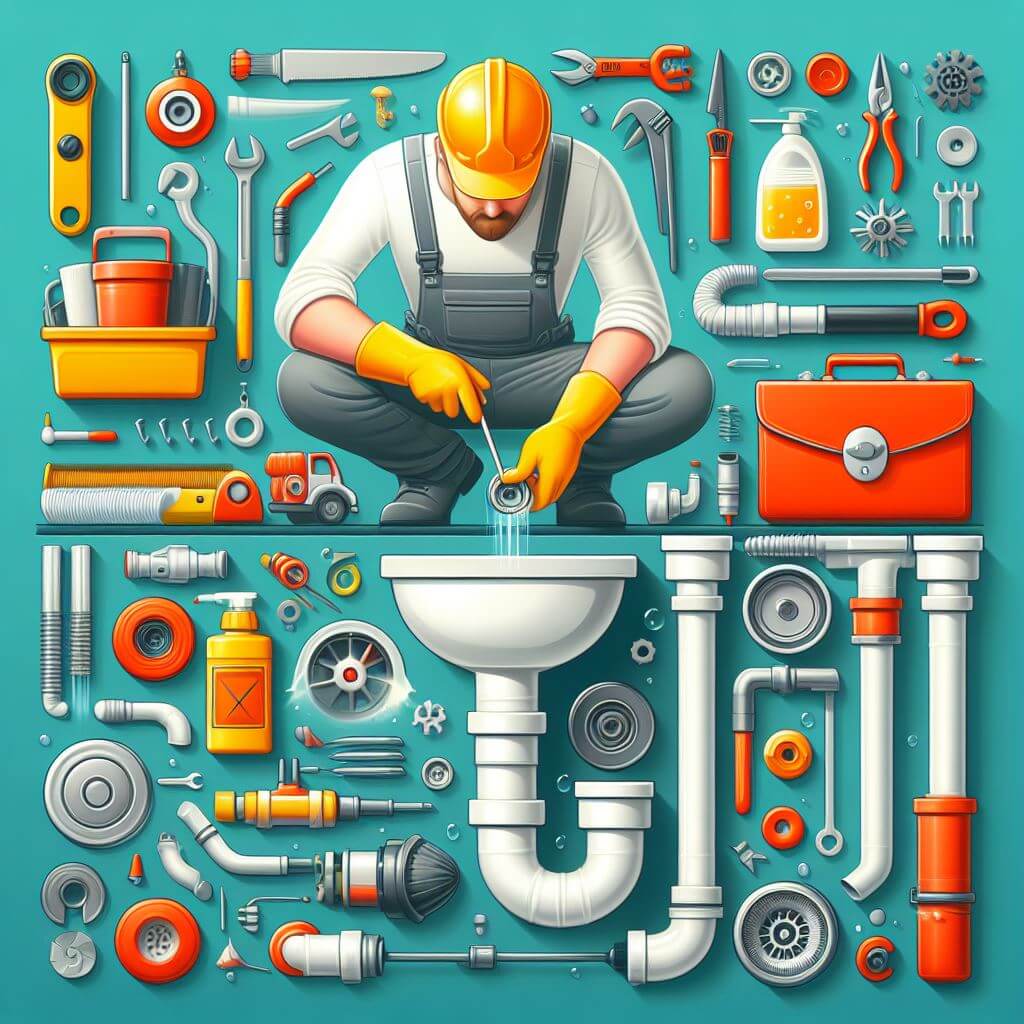Weekend Warrior’s Guide to Home Maintenance: Simple DIY Fixes for Busy People
Maintaining a home can be a daunting task for busy people, especially those who don’t have the time or resources to hire professionals. However, neglecting home maintenance can lead to costly repairs and potential safety hazards. Fortunately, there are several simple DIY fixes that weekend warriors can tackle to keep their homes in good condition.
From fixing leaky faucets to repairing drywall, there are many home maintenance tasks that can be completed with just a few basic tools and a little bit of know-how. This guide will provide tips and tricks for busy homeowners who want to take on these tasks themselves. By following these simple steps, homeowners can save time and money by avoiding costly repairs and ensuring that their homes are safe and comfortable places to live.
Getting Started with Home Maintenance
Home maintenance can be a daunting task, especially for those who are new to it. However, with the right tools and knowledge, anyone can become a weekend warrior and tackle simple DIY fixes around the house. In this section, we’ll cover the essentials you need to get started with home maintenance, including tool kit essentials and safety guidelines.
Tool Kit Essentials
Having the right tools is essential for any home maintenance project. Here are some tool kit essentials that every weekend warrior should have:
| Tool | Description |
|---|---|
| Hammer | Used for driving nails and other small tasks |
| Screwdriver Set | Includes various sizes and types of screwdrivers |
| Pliers | Used for gripping and bending wires |
| Utility Knife | Used for cutting various materials |
| Tape Measure | Used for measuring distances and lengths |
| Level | Used for ensuring surfaces are level |
| Adjustable Wrench | Used for tightening or loosening nuts and bolts |
| Safety Glasses | Used for eye protection |
| Work Gloves | Used for hand protection |
Safety Guidelines
Safety should always be a top priority when it comes to home maintenance. Here are some safety guidelines to follow:
- Always wear appropriate safety gear, such as safety glasses and work gloves.
- Turn off power to any electrical circuits before working on them.
- Use caution when working on ladders or other elevated surfaces.
- Make sure all tools are in good condition and functioning properly.
- Follow all manufacturer instructions when using tools or equipment.
- If you’re unsure about how to perform a task safely, seek guidance from a professional.
By following these tool kit essentials and safety guidelines, anyone can get started with home maintenance and become a weekend warrior in no time.
Plumbing Basics
Understanding Your Home’s Plumbing System
Understanding your home’s plumbing system can help you identify and fix common plumbing issues. The plumbing system in your home consists of a network of pipes, valves, and fixtures that work together to provide clean water and remove waste.
The main water supply line brings water into your home and is connected to a water meter, which measures the amount of water you use. From there, the water is distributed to various fixtures and appliances, such as sinks, toilets, and washing machines, through a network of pipes.
To prevent leaks and other plumbing issues, it’s important to know where the shut-off valve is located. This valve can be used to turn off the water supply to your entire home in case of an emergency. It’s also a good idea to know where individual shut-off valves are located for each fixture or appliance in your home.
Replacing a Leaky Faucet Washer
A leaky faucet can be a frustrating and wasteful problem. In many cases, the cause of a leaky faucet is a worn-out washer. To replace a leaky faucet washer, follow these simple steps:
- Turn off the water supply to the faucet.
- Remove the handle and unscrew the packing nut.
- Remove the stem and replace the washer.
- Reassemble the faucet and turn the water supply back on.
It’s important to use the correct size and type of washer for your faucet. If you’re not sure what type of washer you need, take the old washer to a hardware store and ask for assistance.
By understanding the basics of your home’s plumbing system and knowing how to replace a leaky faucet washer, you can save time and money on common plumbing repairs.

Heating and Cooling Maintenance
Optimizing Your HVAC Performance
Heating and cooling systems are essential for keeping homes comfortable throughout the year. However, they can also be a source of high energy bills if not properly maintained. To optimize the performance of your heating and cooling system, there are a few things you can do.
First, make sure your HVAC system is the right size for your home. An improperly sized system can lead to inefficiencies and higher energy bills. Second, keep your thermostat at a consistent temperature to avoid overworking your system. Third, seal air leaks around doors and windows to prevent air from escaping and causing your system to work harder than necessary.
Changing Air Filters in HVAC Systems
One of the most important maintenance tasks for your HVAC system is changing the air filter. A dirty air filter can reduce the efficiency of your system, increase energy bills, and even lead to system failure.
It is recommended to change your air filter every 1-3 months, depending on the type of filter and how often you use your system. For example, if you have pets or suffer from allergies, you may need to change your filter more frequently.
To change your air filter, follow these simple steps:
- Turn off your HVAC system.
- Locate the air filter, which is typically found near the return air duct or blower compartment.
- Remove the old filter and dispose of it properly.
- Insert the new filter, making sure it is facing the correct direction.
- Turn your HVAC system back on.
By regularly changing your air filter, you can improve the air quality in your home and extend the life of your HVAC system.
Electrical System Care
Taking care of your home’s electrical system is crucial for preventing potential hazards like electrical fires or shocks. Here are a few simple DIY fixes that can help you maintain your electrical system and keep it running smoothly.
Identifying Common Electrical Issues
Before you can fix any electrical issue, you need to identify it. Here are some common electrical issues that you may encounter:
- Flickering lights: This can be caused by an overloaded circuit, a loose bulb, or a faulty light switch.
- Tripping circuit breaker: This can be caused by an overloaded circuit, a short circuit, or a ground fault.
- Dead outlets: This can be caused by a tripped circuit breaker, a blown fuse, or a faulty outlet.
If you encounter any of these issues, it’s best to call a professional electrician to diagnose and fix the problem.
Preventive Electrical Maintenance
Regular maintenance of your home’s electrical systems ensures efficiency and prevents potential hazards. Here are some preventive electrical maintenance tasks that you can do yourself:
- Keep electrical appliances clean: Regularly clean dust and debris from electrical appliances to maintain optimal performance and prevent overheating.
- Store electrical cords properly: Avoid tightly coiling cords or running them under rugs, as they can cause damage and pose tripping hazards.
- Test GFCI outlets: Ground Fault Circuit Interrupter (GFCI) outlets are designed to protect against electrical shock. Test your GFCI outlets regularly to ensure that they are working properly.
- Replace old outlets and switches: Old outlets and switches can become loose or damaged over time, which can cause electrical issues. Replace them with new ones to ensure proper functioning.
- Install surge protectors: Power surges can damage your electrical devices. Installing surge protectors can help protect your devices from damage.
By following these simple DIY fixes, you can maintain your home’s electrical system and prevent potential hazards. However, if you encounter any major electrical issues, it’s best to call a professional electrician to diagnose and fix the problem.
Caring for Your Home’s Exterior
Exterior Inspection Routines
Regular exterior inspections are crucial for identifying potential issues before they become major problems. A thorough inspection should be done at least once a year, and more frequently if the area experiences harsh weather conditions. Here are some key areas to inspect:
- Roof: Check for any missing or damaged shingles, as well as signs of wear and tear. If any issues are identified, it’s best to call in a professional to make repairs.
- Gutters and Downspouts: Remove any debris that may have accumulated and check for any signs of damage. Make sure the downspouts are directing water away from the foundation of the house.
- Siding: Look for any cracks, chipping, or peeling paint. These can be signs of water damage or insect infestation.
- Windows and Doors: Check for any gaps or cracks that could let in drafts or pests. Replace any damaged weather stripping or caulking.
Maintaining Outdoor Spaces
The exterior of a home includes more than just the house itself. Here are some tips for maintaining the outdoor spaces around your home:
- Landscaping: Regularly trim trees and bushes away from the house to prevent damage from falling branches or leaves. Keep the lawn mowed and remove any weeds or debris.
- Outdoor Lighting: Replace any burnt out bulbs and make sure all fixtures are securely attached.
- Driveway and Walkways: Repair any cracks or potholes to prevent tripping hazards. Regularly sweep and power wash to remove any dirt or debris.
By following these simple exterior maintenance routines, homeowners can help protect their homes from damage and ensure that they continue to look their best for years to come.
Interior Maintenance
Walls and Ceilings
The walls and ceilings are often overlooked when it comes to home maintenance. However, keeping them in good condition can help prevent bigger problems down the line. Here are some simple DIY fixes that can be done over the weekend:
- Fill in holes and cracks with spackle or joint compound. For larger holes, use a patching kit.
- Touch up paint on scuffed or chipped areas. Be sure to match the paint color and finish.
- Clean walls and ceilings with a gentle cleaner and a soft sponge or cloth. Avoid using abrasive cleaners or scrubbers that can damage the surface.
Regular maintenance of walls and ceilings can help maintain the appearance of your home and prevent more costly repairs in the future.
Flooring and Carpets
Flooring and carpets take a lot of wear and tear over time. Here are some simple DIY fixes to keep them looking their best:
- Vacuum carpets regularly to remove dirt and debris. Use a spot cleaner for stains.
- Sweep or mop hard floors to remove dirt and grime. Use a cleaner specific to the type of flooring.
- Repair loose or damaged flooring with a patching kit or replacement planks or tiles.
Regular maintenance of flooring and carpets can help prolong their lifespan and prevent the need for costly replacements.
By taking the time to perform simple DIY fixes on walls, ceilings, flooring, and carpets, homeowners can save time and money in the long run.
Kitchen Upkeep
Appliance Care
Keeping kitchen appliances in good working order is crucial to maintaining a functional and efficient kitchen. Here are some simple DIY fixes for common appliance issues:
- Refrigerator: Clean the coils at least twice a year to prevent dust buildup, which can cause the compressor to overheat. Check the door seals for cracks and replace if necessary to ensure a tight seal.
- Dishwasher: Clean the spray arm and filter regularly to prevent clogs and ensure proper cleaning. Run a cycle with white vinegar to remove any buildup and eliminate odors.
- Oven: Clean the oven regularly to prevent buildup of grease and food debris. Use a mixture of baking soda and water to scrub the interior, and wipe down the exterior with a damp cloth.
Countertop Maintenance
Countertops are a high-traffic area in the kitchen and can easily become stained or damaged. Here are some tips for keeping them looking their best:
- Granite or Marble: Wipe up spills immediately to prevent staining. Use a pH-neutral cleaner and avoid harsh chemicals or abrasive sponges.
- Laminate or Formica: Use a mild soap and water to clean, and avoid abrasive cleaners or scrubbers. Apply a coat of wax every few months to protect the surface.
- Butcher Block: Apply mineral oil or beeswax regularly to prevent drying and cracking. Wipe up spills immediately to prevent staining and sanitize with a mixture of vinegar and water.
By following these simple maintenance tips, homeowners can keep their kitchen appliances and countertops in top condition without spending a lot of time or money.
Bathroom Maintenance
Maintaining a clean and functional bathroom is essential for any homeowner. Regular upkeep can prevent costly repairs and ensure that your bathroom remains in good condition for years to come. In this section, we will explore some simple DIY fixes for busy people to keep their bathroom in top shape.
Caulking Around Bathtubs and Sinks
Caulking is an essential part of bathroom maintenance as it helps to prevent water from seeping into the walls or floors. Over time, caulking can crack or become discolored, leading to water damage and mold growth. To prevent this, it is important to regularly inspect and replace the caulking around your bathtub and sink.
To replace the caulking, follow these simple steps:
- Remove the old caulking using a sharp blade or scraper.
- Clean the area thoroughly with a mildew remover or bleach solution.
- Apply a new bead of caulk using a caulking gun.
- Smooth the caulk with a caulk smoothing tool or your finger.
- Allow the caulk to dry for at least 24 hours before using the bathtub or sink.
By following these steps, you can ensure that your bathroom remains free of water damage and mold growth.
Toilet Upkeep
Toilets are one of the most frequently used fixtures in a bathroom, and as such, they require regular upkeep to prevent clogs and leaks. Here are some simple DIY fixes for toilet upkeep:
- Check the toilet tank for leaks by adding a few drops of food coloring to the water. If the water in the bowl changes color, you have a leak that needs to be fixed.
- Clean the toilet bowl regularly with a toilet brush and a mild cleaner.
- Use a plunger to unclog the toilet if necessary.
- Replace the toilet flapper if it is not sealing properly.
By following these simple steps, you can prevent costly repairs and ensure that your toilet remains in good working order.
Energy Efficiency Improvements
Sealing Air Leaks
One of the simplest and most cost-effective ways to improve energy efficiency in the home is by sealing air leaks. Air leaks can cause significant energy loss, making heating and cooling systems work harder than necessary and driving up energy bills. Sealing air leaks can reduce energy bills by up to 20%.
To identify air leaks, homeowners can use a smoke pencil or incense stick to detect drafts around windows, doors, and other openings. Once identified, air leaks can be sealed using caulk, weatherstripping, or foam sealant.
Upgrading to Energy-Efficient Appliances
Another way to improve energy efficiency in the home is by upgrading to energy-efficient appliances. Energy-efficient appliances use less energy than traditional appliances, resulting in lower energy bills and reduced environmental impact.
When shopping for appliances, homeowners should look for the ENERGY STAR label, which indicates that the appliance meets strict energy efficiency guidelines set by the U.S. Environmental Protection Agency. ENERGY STAR appliances can save homeowners up to 30% on energy bills compared to traditional appliances.
In addition to upgrading appliances, homeowners can also make small changes to their daily routines to improve energy efficiency. For example, turning off lights and electronics when not in use, using a programmable thermostat to regulate heating and cooling, and washing clothes in cold water can all help reduce energy consumption and lower energy bills.
Seasonal Home Care
Home maintenance is an essential part of homeownership. Regular upkeep guarantees the safety, durability, and health of your property. As a weekend warrior, you can take on simple DIY fixes to keep your home in good shape. Here are some seasonal home care tips to help you get started.
Preparing for Winter
Winter is a challenging season for homeowners. The cold weather can cause damage to your home. Therefore, it’s crucial to prepare your home for the winter season. Here are some things you can do:
- Inspect your roof for leaks, cracks, or missing shingles. Repair any damage before the winter season.
- Clean your gutters and downspouts to prevent ice dams. Clogged gutters can cause water to back up and freeze, damaging your roof and walls.
- Check your windows and doors for drafts. Seal any gaps with weatherstripping or caulk to keep the cold air out.
- Have your heating system serviced by a professional. A well-maintained heating system can save you money on energy bills and keep you warm during the winter season.
Summer Maintenance Checklist
Summer is a great time to tackle home maintenance tasks. The warm weather makes it easy to work outside, and you can get your home ready for the upcoming seasons. Here are some things you can do:
- Inspect your air conditioning system and replace the filter. A clean filter can improve indoor air quality and save you money on energy bills.
- Clean your windows and screens. Dirty windows can reduce natural light and make your home look dull. Clean screens can improve airflow and keep bugs out.
- Check your deck or patio for signs of wear and tear. Repair any damage and apply a fresh coat of stain or paint to protect it from the elements.
- Inspect your outdoor lighting fixtures. Replace any burned-out bulbs and clean the fixtures to improve visibility and safety.
By following these seasonal home care tips, you can keep your home in good shape and avoid costly repairs. As a weekend warrior, you can take on simple DIY fixes to keep your home safe, comfortable, and efficient year-round.
Preventative Measures
Routine Inspection Schedules
Preventative maintenance is key to keeping a home in good condition. By performing routine checks, homeowners can catch issues before they become major problems. Here are some recommended inspection schedules:
- Monthly: Check HVAC filters and replace them if necessary. Inspect plumbing for leaks. Test smoke detectors and carbon monoxide detectors.
- Quarterly: Inspect the roof for damage, especially after severe weather. Check gutters and downspouts for debris. Test garage door opener safety features.
- Annually: Have the HVAC system serviced by a professional. Inspect the exterior of the home, including the foundation and siding. Clean and inspect the chimney.
Immediate Action for Common Issues
While routine inspections can prevent major issues, sometimes problems arise unexpectedly. Here are some common issues and what homeowners can do to address them:
- Leaky faucet: Fixing a leaky faucet is a simple DIY project that can save homeowners money on their water bill. Most faucet leaks are caused by worn-out washers, which are easy to replace.
- Clogged drain: A clogged drain can be a frustrating issue, but it’s usually easy to fix. Try using a plunger or a drain snake to remove the blockage. If that doesn’t work, homeowners can use a chemical drain cleaner, but they should be careful to follow the instructions and use protective gear.
- Power outage: Power outages can be caused by severe weather or other issues. Homeowners should have a flashlight and extra batteries on hand, as well as a backup generator if possible. If the power outage lasts for an extended period of time, homeowners should take steps to keep their food from spoiling and stay warm.
By following these preventative measures and taking immediate action when issues arise, homeowners can keep their homes in good condition and avoid costly repairs.
Laundry Room Tips
Maintaining a laundry room can be a daunting task, but with these simple tips, you can ensure that your laundry room stays in top shape. In this section, we will cover two essential aspects of laundry room maintenance: cleaning dryer vents and washer maintenance.
Cleaning Dryer Vents
Cleaning dryer vents is a crucial step in preventing house fires. Over time, lint can build up in the dryer vent, reducing airflow and causing the dryer to overheat. This can lead to a fire hazard. To prevent this, it is recommended to clean the dryer vent at least once a year.
To clean the dryer vent, follow these simple steps:
- Turn off the dryer and unplug it from the power source.
- Locate the dryer vent on the back of the dryer.
- Disconnect the vent from the dryer.
- Use a vacuum cleaner or a lint brush to remove any lint or debris from the vent.
- Reconnect the vent to the dryer.
- Turn on the dryer and ensure that the vent is functioning correctly.
By cleaning the dryer vent regularly, you can prevent house fires and extend the life of your dryer.
Washer Maintenance
Washer maintenance is essential to ensure that your washer operates efficiently and lasts for a long time. Here are a few tips to keep your washer in top shape:
- Clean the washer regularly: Over time, dirt, soap scum, and other debris can build up in the washer. This can cause the washer to smell bad and reduce its efficiency. To prevent this, clean the washer at least once a month using a washer cleaner.
- Check the hoses: Check the hoses for any signs of wear and tear. If you notice any cracks or leaks, replace the hoses immediately.
- Balance the washer: If the washer is not balanced, it can cause excessive vibration, noise, and damage to the washer. To balance the washer, adjust the feet of the washer until it is level.
By following these simple tips, you can ensure that your washer operates efficiently and lasts for a long time.
Home Safety Checks
Keeping your home safe is of utmost importance, and regular safety checks can help prevent accidents and emergencies. Here are some simple DIY fixes that can keep your home safe.
Fire Safety Equipment
Having the right fire safety equipment in your home can save lives. Make sure you have working smoke detectors on every level of your home, including inside and outside of sleeping areas. Test them monthly and replace the batteries at least once a year. You can also consider installing a carbon monoxide detector to detect this odorless gas that can be deadly.
In addition, it’s important to have fire extinguishers in your home. Place them in areas where fires are most likely to occur, such as the kitchen and garage. Make sure everyone in your household knows where they are located and how to use them. Remember, fire extinguishers are only effective for small fires, and you should always call 911 for larger fires.
Carbon Monoxide Detectors
Carbon monoxide is an odorless and colorless gas that is produced by fuel-burning appliances such as gas stoves, water heaters, and furnaces. Exposure to high levels of carbon monoxide can be deadly. To prevent this, install carbon monoxide detectors on every level of your home, including inside and outside of sleeping areas. Test them monthly and replace the batteries at least once a year.
It’s also important to have your fuel-burning appliances inspected annually by a qualified technician. This can help detect any potential carbon monoxide leaks and ensure that your appliances are functioning properly. In addition, make sure that all fuel-burning appliances are properly vented to the outside to prevent the buildup of carbon monoxide.
Radiators and Heating
Maintaining the heating system of a home is essential to ensure comfort during the colder months. Radiators are a common heating system used in many homes. Here are some simple DIY fixes that busy homeowners can do to maintain their radiators and heating system.
Bleeding Radiators
One common issue with radiators is trapped air, which can cause the radiator to not heat up properly. Bleeding the radiator can help release the trapped air and improve the radiator’s performance. Here is a step-by-step guide to bleeding a radiator:
- Turn off the heating system and allow the radiator to cool down.
- Locate the radiator’s bleed valve, which can be found on one of the sides or at the top of the radiator.
- Place a container or towel beneath the valve to catch any water that may come out.
- Use a radiator key or a flat screwdriver to turn the valve anticlockwise. You should hear a hissing sound as the air escapes.
- Once water starts to come out, tighten the valve back up.
- Check the pressure gauge on the boiler to make sure it is at the correct level.
Troubleshooting Heating Issues
If the radiator is not heating up properly, there may be other issues that need to be addressed. Here are some common troubleshooting tips:
- Check the thermostat settings to make sure they are correct.
- Inspect the radiator pipes for any leaks or cracks.
- Check the pressure gauge on the boiler to make sure it is at the correct level.
- If the heating system is making strange noises, it may be due to trapped air or a faulty pump. Bleeding the radiators can help release trapped air, but a faulty pump will require a professional to fix it.
By performing these simple DIY fixes, homeowners can maintain their radiators and heating system, ensuring they stay warm and comfortable during the colder months.
Frequently Asked Questions
What are the essential tools every weekend warrior should have for home repairs?
For weekend warriors, it is important to have a basic set of tools that can help them tackle common home repairs. Some essential tools that every weekend warrior should have include a hammer, screwdrivers, pliers, a wrench set, a tape measure, a level, a utility knife, and a power drill. These tools can help you handle most home repairs and maintenance tasks.
How can I prioritize home maintenance tasks effectively?
Prioritizing home maintenance tasks can be overwhelming, but it is important to focus on the most critical tasks first. Start with tasks that can cause damage to your home or put your safety at risk if left unattended. Examples include fixing leaky pipes, repairing faulty electrical wiring, and replacing damaged roof shingles. Once you have addressed these critical tasks, move on to less urgent tasks such as cleaning gutters, replacing air filters, and inspecting windows and doors for drafts.
What are some quick DIY fixes that can be done in under an hour?
There are several quick DIY fixes that can be done in under an hour, including fixing a leaky faucet, replacing a light fixture, unclogging a drain, and patching a small hole in drywall. These tasks require minimal tools and can be completed easily with a little bit of know-how.
How often should routine home maintenance checks be performed?
Routine home maintenance checks should be performed on a regular basis to ensure that your home is in good condition. Some tasks should be done monthly, such as changing air filters and checking smoke detectors, while others can be done annually, such as inspecting the roof and cleaning gutters. It is important to create a maintenance schedule that works for your home and lifestyle.
Can you provide tips for creating a home maintenance schedule?
Creating a home maintenance schedule can help you stay on top of routine tasks and prevent major repairs down the line. Start by making a list of all the tasks that need to be done, then prioritize them based on urgency and frequency. Next, assign each task to a specific month or season and create reminders for yourself to ensure that you stay on track.
What are the best resources for learning basic home repair skills?
There are several resources available for learning basic home repair skills, including online tutorials, books, and workshops. Home improvement stores often offer free workshops on topics such as plumbing, electrical work, and painting. Online tutorials and books can also be a great resource for learning new skills and techniques.





